The sheer variety of queer comics shouldn’t be a surprise to regular readers of this blog. But the Justin Hall-edited No Straight Lines1 anthology will probably teach something to all of you (even I did discovered a few artists), covering as it does 40 years of cartooning, from the underground comix of the 70s to current webcomics.
There was a real need of such a wide-ranging collection, and even though Hall wasn’t able to include everybody2, he does a rather good job of organizing such disparate works and showing the trends over the decades. I want to point out that the last time somebody tried something similar, it was Robert Triptow, one of the editors of Gay Comix/Comics, with his 1989 book Gay Comics, which I still recommend.
Hall wisely chose to follow a (more or less) chronological path instead of anything fancier, but that doesn’t mean he has nothing interesting to say, far from it. The tension between specialized comics (by which I mean comics made by and for a specific group of people) and mainstream audience, the evolution from the urgent need for visibility to the creation of complexified issues and characters, all these and more are covered in a few pages. The book itself is divided in three parts, and as hazardous as making sense of recent history can be, it seems to me Hall’s choices work well: we begin with the late 60s/early 70s, gag strips and coming-out lesbian stories being published in gay magazines and underground comix; next up is the punk/queer scene and the rise of AIDS as a subject; finally, the emergence of trans creators and the appearance of webcomics show examples of more recent trends.
Though I can’t comment on every included artist (the complete list is in the preview), I’d like to say a few words about the aspects of this book that I think are particularly important.
The first one is the historical significance of the early works included here, such as Joe Johnson’s Miss Thing, a mid 60s gag strip that looks rather radical when seen from our vantage point. A lot of those works are mostly forgotten, their authors often deceased or nobody interested in reprinting them3. But apart from the fact that they’re still good, ignoring them is the same as thinking modern gay activism begun in the USA with Stonewall or in my own country with the FHAR.
Another thing I really liked in Hall’s book is the care given to showing how actively involved in early (and later) comix lesbian artists were. The first work shown is Trina Robbins’s strip about the life of Sandy Crumb (yes, Robert Crumb’s sister), her coming-out and her living in a hippie commune (those really were the 70s). The foremothers of non-erotic queer comix thus can be said to be two women, one straight and one lesbian.
The beginnings of the 80s are most typified as the solidification of LGBT activism by the launch of the Gay Comix series in 1981, first edited by Howard Cruse and published by Kitchen Sink (covers and contents here). These comix, created equally by gay and lesbian artists, were a smörgåsbord of styles and themes, and are well represented in Hall’s book. If you like what you see of Cruse’s work there, have a look at From Headrack to Claude, a collection of his gay-themed strips. The existential crisis that accompanied the AIDS epidemic was an important component of the contributions in Gay Comix, and is well represented here.
The 80s strips were not all about life-threatening diseases, nor were they all mindless fun, as Hall shows with his selection from Tim Barela’s Leonard & Larry. I love this strip, which ended a decade ago, for its uplifting portrait of gay domesticity, and I wanted to mention it here because I’d love to see a reprint of the collections, which are now hard to find and don’t even cover the end of the series.
Another important facet of the book is the inclusion of non-Anglophone artists, such as Nazario and Fabrice Neaud. The openly gay Spanish artist Nazario, whose Anarcoma (1980) was translated in English back in 1984, is regarded as one of the most important artists to come out of La Movida; as for Fabrice Neaud, the lauded French artist published his autobiographical Journal between 1996 and 2002 but has never been published in English, apart from a few pages years ago. Showing stories from these two largely unknown artists (well, unknown in the USA) is a public service, in my opinion.
Of course, the most famous European gay cartoonist is also present: Hall gives us some of Ralf König’s more recent work, proving, if need be, that the German artist is a master of the human comedy (and he’s good at dogs, too).
The rise of trans issues and characters from the early 2000s, it seems to me as momentous as what happened for gay people decades before, is another strong point made by Hall in this book, with the inclusion of artists such as Joey Alison Sayers or Gina Kamentsky, among others.
For a long time, queer artists were usually either published in gay magazines or self-published. But with the slow collapse of print magazines, webcomics are now firmly in the position of offering niche artists an outlet for their creativity. Hall also stresses that point, by offering a large variety of queer webcomics4, including some which are still running.
From the early gag strips to the current explosion of webcomics, more than 40 years have passed5. Some of the artists aren’t with us anymore, but books like No Straight Lines keep their memory alive; thankfully, other artists are still going strong, while new ones appear all the time, making me very optimistic for the future of queer comics.
Notes:
- This 328-page hardcover is published by Fantagraphics, which offers a 36-page preview on their site, as well as in the pdf format. The book is available everywhere, including from Amazon. A digital version is also available. ↩
- The only choice Hall made that I’d really dispute is the decision not to include any porn comics (as opposed to comics with sex which is not explicit), though he does explain his choice and discuss them in his introduction–after all, the earliest comics one might call “gay” were erotic, and they still are an important part of the gay comics scene. I can understand that including them would have lead to a twice or thrice as long book, but I also wonder whether Fantagraphics might not have been unwilling to publish explicit sex in their regular catalog, though they used to have a (mostly straight) porn imprint. ↩
- Curiously, Hall doesn’t even mention A. Jay (Allen Shapiro)’s The Adventures of Harry Chess: That Man from A.U.N.T.I.E., a randy spoof of That Man from U.N.C.L.E. that started in 1964 and is often considered as the first gay strip. See here for a few examples.
Also, I’ll use this opportunity to point you toward an interview I published years ago with Sean, an early gay artist included here, who did gag strips and lots of good erotic work. ↩ - I can’t write this without mentioning Tim Fish, toward whom I have a real debt, because of his online anthology Young Bottoms In Love (2002-2007), which published three stories I wrote, including one drawn by Spanish artist Roger Zanni, that Justin Hall has selected for his book. ↩
- If you’re interested in reading a more detailed overview of the history of queer comics, head to the Gay League site ↩

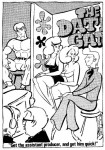
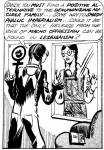
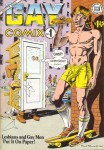

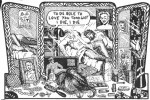
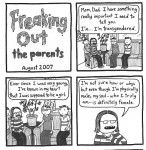
 Bluesky feed
Bluesky feed
No, that list of creators is not quite complete.
Hello, Christine.
As I said, I couldn’t comment on everybody’s contribution. And I’ve linked to a complete list of contributors.
But I’ve just done what I also wanted to do: I’ve added your online strip The Princess to my Links page.